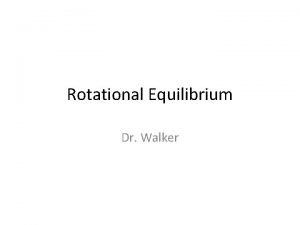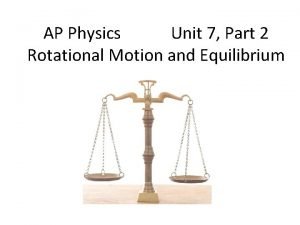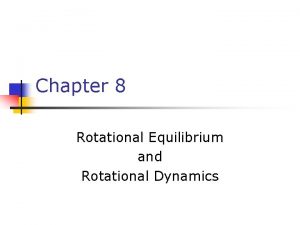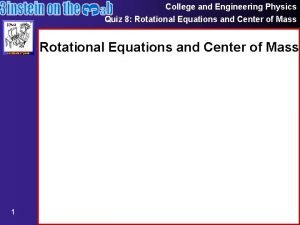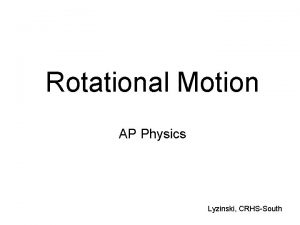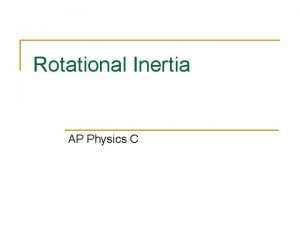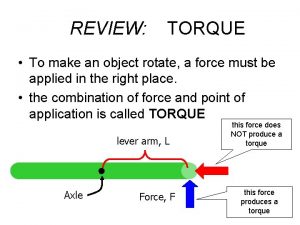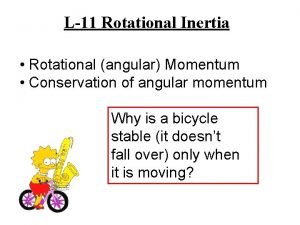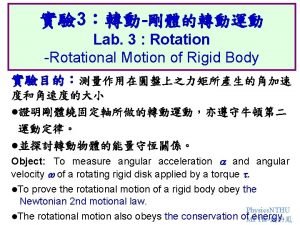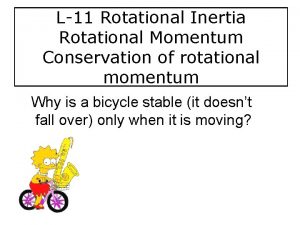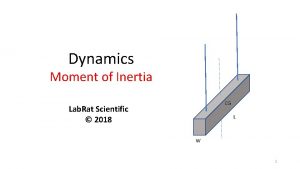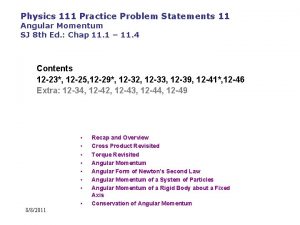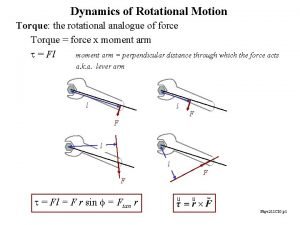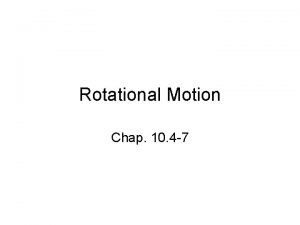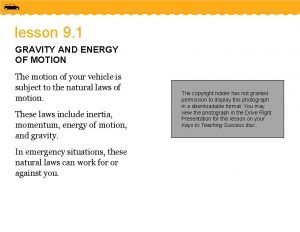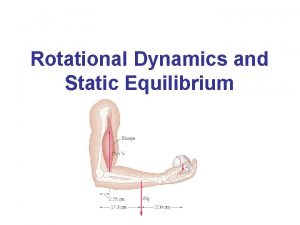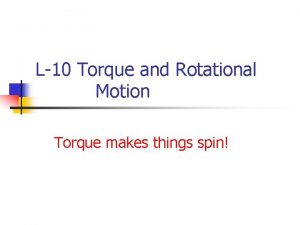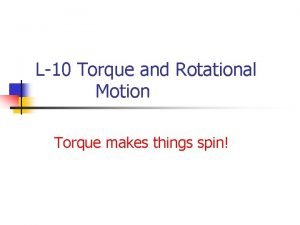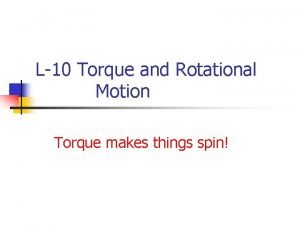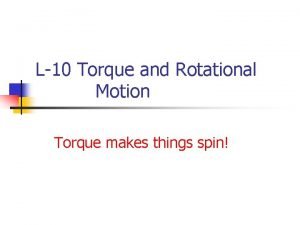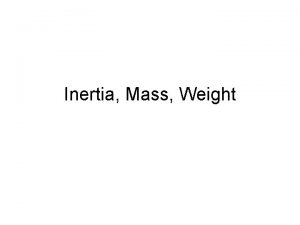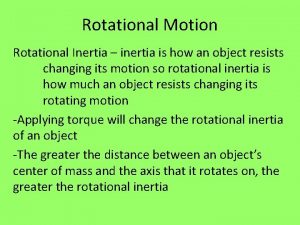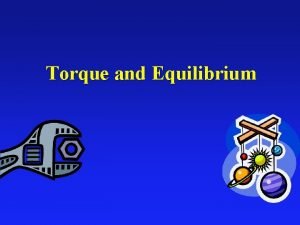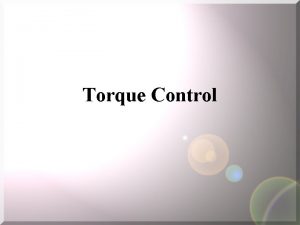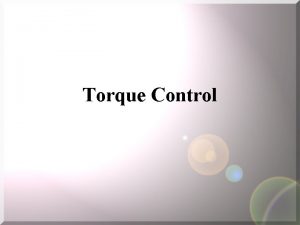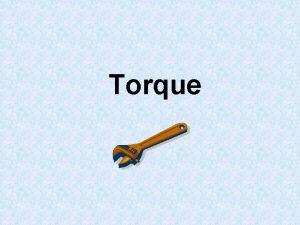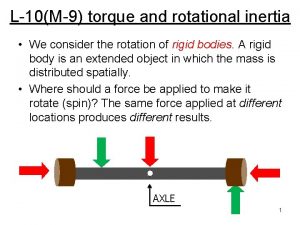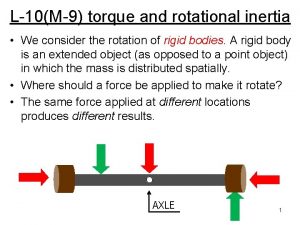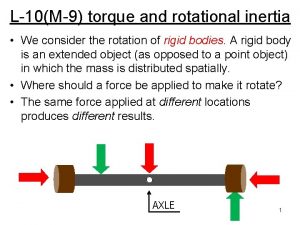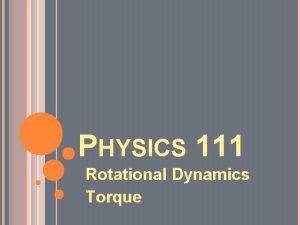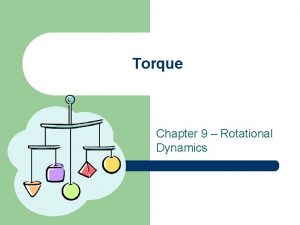L10 torque and rotational inertia What does it

![TORQUE [ t (tau)] • To make an object rotate, a force must be TORQUE [ t (tau)] • To make an object rotate, a force must be](https://slidetodoc.com/presentation_image_h/e8a6c228ca512018aeda1e60c8833752/image-2.jpg)


















- Slides: 20

L-10 torque and rotational inertia What does it take to start an object rotating? TORQUE How do I apply a force to make the rod rotate about the axle? Not just anywhere! AXLE
![TORQUE t tau To make an object rotate a force must be TORQUE [ t (tau)] • To make an object rotate, a force must be](https://slidetodoc.com/presentation_image_h/e8a6c228ca512018aeda1e60c8833752/image-2.jpg)
TORQUE [ t (tau)] • To make an object rotate, a force must be applied in the right place. • the combination of force and point of application is called TORQUE • We use the Greek letter, t (tau) for torque lever arm, L Axle Force, F

Torque (t) = force (F) x lever arm (L) t=F L Force must be in Newtons, N the lever arm length in meters, m then torque in units of N m

Torque example F L What is the torque on a bolt applied with a wrench that has a lever arm: L= 20 cm with a force: F = 30 N? Solution: t= F L = 30 N (1/5) m =6 Nm For the same force, you get more torque with a bigger wrench the job is easier!

Homer attempts to straighten out the leaning tower of Pisa lever fulcrum

Net Force = 0 , Net Torque ≠ 0 10 N • > The net force = 0, since the forces are applied in opposite directions so it will not accelerate. • > However, together these forces will make the rod rotate in the clockwise direction.

Net torque = 0, net force ≠ 0 The rod will accelerate upward under these two forces, but will not rotate.

Balancing torques 20 N 1 m 0. 5 m Left torque = 10 N x 1 m = 10 n m Right torque = 20 N x 0. 5 m = 10 N m

Equilibrium • To ensure that an object does not accelerate or rotate two conditions must be met: • net force = 0 • net torque = 0 • this results in the practical 4 -1 “ladder rule”

When is an object stable? • If you can tip it over a bit and it doesn’t fall • The object may wobble a bit but it eventually stops and settles down to its upright position. A thinner object is easier to topple An object that is thicker at its base is more stable

Why do tall objects tend to fall over • Every object has a special point called the center of gravity (CG). The CG is usually right smack in the center of the object. • if the center of gravity is supported, the object will not fall over. • The lower the CG the more stable an object is. stable not easy to knock over!

Condition for stability If the CG is above the edge, the object will not fall CG

when does it fall over? CG STABLE CG NOT STABLE If the vertical line extending down from the CG is inside the edge the object will return to its upright position the torque due to gravity brings it back.

Stable structures Structures are wider at their base to lower their center of gravity

Playing with blocks CG If the center of gravity is supported, the blocks do not fall over

High Profile Vehicles wind As more stuff is loaded into a semi, its center of gravity moves upward, making it susceptible to tipping over in high winds.

rotational inertia (or, moment of inertia), symbol I • Rotational inertia is a parameter that is used to quantify how much torque it takes to get a particular object rotating • it depends not only on the mass of the object, but where the mass is relative to the hinge or axis of rotation • the rotational inertia is bigger, if more mass is located farther from the axis.

rotational inertia examples Rods of equal mass m and length L axis through center axis through end

How fast does it spin? • For spinning or rotational motion, the rotational inertia of an object plays the same role as ordinary mass for simple motion • For a given amount of torque applied to an object, its rotational inertia determines its rotational acceleration the smaller the rotational inertia, the bigger the rotational acceleration

Same torque, different rotational inertia Big rotational inertia Small rotational inertia spins slow spins fast
 Rotational inertia and torque
Rotational inertia and torque Ap physics 1 unit 7 mcq
Ap physics 1 unit 7 mcq Torque free body diagram
Torque free body diagram Second condition of equilibrium
Second condition of equilibrium Physics equations quiz
Physics equations quiz Translational and rotational motion
Translational and rotational motion Rotational inertia ap physics 1
Rotational inertia ap physics 1 Units for rotational inertia
Units for rotational inertia Inertia
Inertia Inertia of a rod
Inertia of a rod Rotational inertia unit
Rotational inertia unit Rotational inertia
Rotational inertia Bifilar pendulum moment of inertia formula
Bifilar pendulum moment of inertia formula A sanding disk with rotational inertia
A sanding disk with rotational inertia Torque is the rotational analogue of force
Torque is the rotational analogue of force Torque rotational motion
Torque rotational motion How does inertia affect your vehicle and passengers
How does inertia affect your vehicle and passengers Plane of reflection of cuboid
Plane of reflection of cuboid Rotational motion and the law of gravity
Rotational motion and the law of gravity Static rotational equilibrium
Static rotational equilibrium Distinguish between rotational and irrotational flow
Distinguish between rotational and irrotational flow
